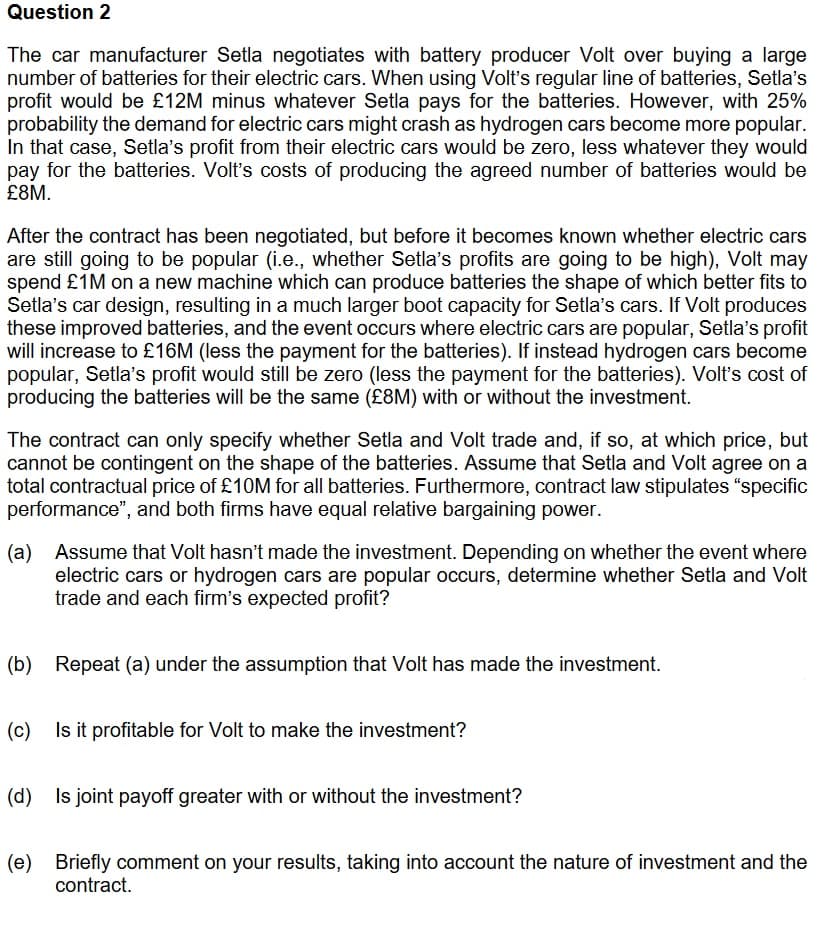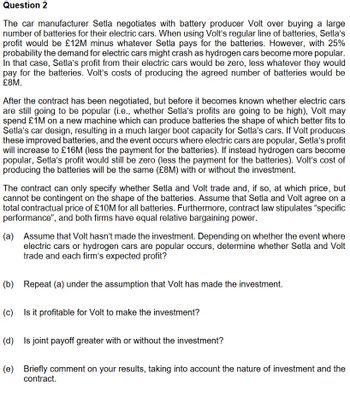The car manufacturer Setla negotiates with battery producer Volt over buying a larg number of batteries for their electric cars. When using Volt's regular line of batteries, Setla profit would be £12M minus whatever Setla pays for the batteries. However, with 25 probability the demand for electric cars might crash as hydrogen cars become more popula In that case, Setla's profit from their electric cars would be zero, less whatever they wou pay for the batteries. Volt's costs of producing the agreed number of batteries would b £8M. After the contract has been negotiated, but before it becomes known whether electric car are still going to be popular (i.e., whether Setla's profits are going to be high), Volt ma spend £1M on a new machine which can produce batteries the shape of which better fits Setla's car design, resulting in a much larger boot capacity for Setla's cars. If Volt produce
The car manufacturer Setla negotiates with battery producer Volt over buying a larg number of batteries for their electric cars. When using Volt's regular line of batteries, Setla profit would be £12M minus whatever Setla pays for the batteries. However, with 25 probability the demand for electric cars might crash as hydrogen cars become more popula In that case, Setla's profit from their electric cars would be zero, less whatever they wou pay for the batteries. Volt's costs of producing the agreed number of batteries would b £8M. After the contract has been negotiated, but before it becomes known whether electric car are still going to be popular (i.e., whether Setla's profits are going to be high), Volt ma spend £1M on a new machine which can produce batteries the shape of which better fits Setla's car design, resulting in a much larger boot capacity for Setla's cars. If Volt produce
Chapter7: Uncertainty
Section: Chapter Questions
Problem 7.8P
Related questions
Question
100%

Transcribed Image Text:Question 2
The car manufacturer Setla negotiates with battery producer Volt over buying a large
number of batteries for their electric cars. When using Volt's regular line of batteries, Setla's
profit would be £12M minus whatever Setla pays for the batteries. However, with 25%
probability the demand for electric cars might crash as hydrogen cars become more popular.
In that case, Setla's profit from their electric cars would be zero, less whatever they would
pay for the batteries. Volt's costs of producing the agreed number of batteries would be
£8M.
After the contract has been negotiated, but before it becomes known whether electric cars
are still going to be popular (i.e., whether Setla's profits are going to be high), Volt may
spend £1M on a new machine which can produce batteries the shape of which better fits to
Setla's car design, resulting in a much larger boot capacity for Setla's cars. If Volt produces
these improved batteries, and the event occurs where electric cars are popular, Setla's profit
will increase to £16M (less the payment for the batteries). If instead hydrogen cars become
popular, Setla's profit would still be zero (less the payment for the batteries). Volt's cost of
producing the batteries will be the same (£8M) with or without the investment.
The contract can only specify whether Setla and Volt trade and, if so, at which price, but
cannot be contingent on the shape of the batteries. Assume that Setla and Volt agree on a
total contractual price of £10M for all batteries. Furthermore, contract law stipulates "specific
performance", and both firms have equal relative bargaining power.
(a) Assume that Volt hasn't made the investment. Depending on whether the event where
electric cars or hydrogen cars are popular occurs, determine whether Setla and Volt
trade and each firm's expected profit?
(b) Repeat (a) under the assumption that Volt has made the investment.
(c) Is it profitable for Volt to make the investment?
(d) Is joint payoff greater with or without the investment?
(e) Briefly comment on your results, taking into account the nature of investment and the
contract.
Expert Solution
This question has been solved!
Explore an expertly crafted, step-by-step solution for a thorough understanding of key concepts.
Step by step
Solved in 2 steps

Follow-up Questions
Read through expert solutions to related follow-up questions below.
Follow-up Question

Transcribed Image Text:Question 2
The car manufacturer Setla negotiates with battery producer Volt over buying a large
number of batteries for their electric cars. When using Volt's regular line of batteries, Setla's
profit would be £12M minus whatever Setla pays for the batteries. However, with 25%
probability the demand for electric cars might crash as hydrogen cars become more popular.
In that case, Setla's profit from their electric cars would be zero, less whatever they would
pay for the batteries. Volt's costs of producing the agreed number of batteries would be
£8M.
After the contract has been negotiated, but before it becomes known whether electric cars
are still going to be popular (i.e., whether Setla's profits are going to be high), Volt may
spend £1M on a new machine which can produce batteries the shape of which better fits to
Setla's car design, resulting in a much larger boot capacity for Setla's cars. If Volt produces
these improved batteries, and the event occurs where electric cars are popular, Setla's profit
will increase to £16M (less the payment for the batteries). If instead hydrogen cars become
popular, Setla's profit would still be zero (less the payment for the batteries). Volt's cost of
producing the batteries will be the same (£8M) with or without the investment.
The contract can only specify whether Setla and Volt trade and, if so, at which price, but
cannot be contingent on the shape of the batteries. Assume that Setla and Volt agree on a
total contractual price of £10M for all batteries. Furthermore, contract law stipulates "specific
performance", and both firms have equal relative bargaining power.
(a) Assume that Volt hasn't made the investment. Depending on whether the event where
electric cars or hydrogen cars are popular occurs, determine whether Setla and Volt
trade and each firm's expected profit?
(b) Repeat (a) under the assumption that Volt has made the investment.
(c) Is it profitable for Volt to make the investment?
(d) Is joint payoff greater with or without the investment?
(e) Briefly comment on your results, taking into account the nature of investment and the
contract.
Solution
Knowledge Booster
Learn more about
Need a deep-dive on the concept behind this application? Look no further. Learn more about this topic, economics and related others by exploring similar questions and additional content below.Recommended textbooks for you


Managerial Economics: A Problem Solving Approach
Economics
ISBN:
9781337106665
Author:
Luke M. Froeb, Brian T. McCann, Michael R. Ward, Mike Shor
Publisher:
Cengage Learning


Managerial Economics: A Problem Solving Approach
Economics
ISBN:
9781337106665
Author:
Luke M. Froeb, Brian T. McCann, Michael R. Ward, Mike Shor
Publisher:
Cengage Learning